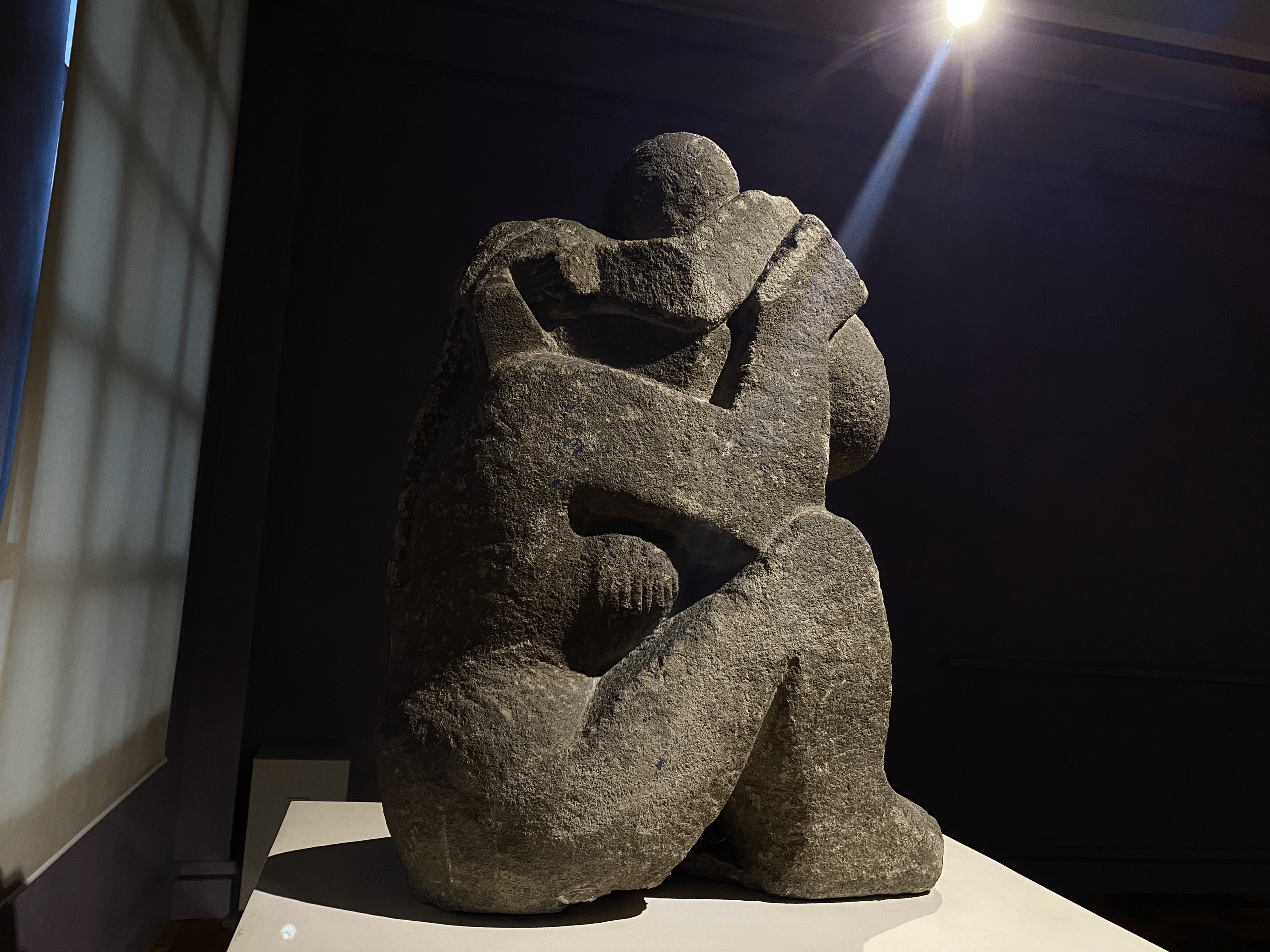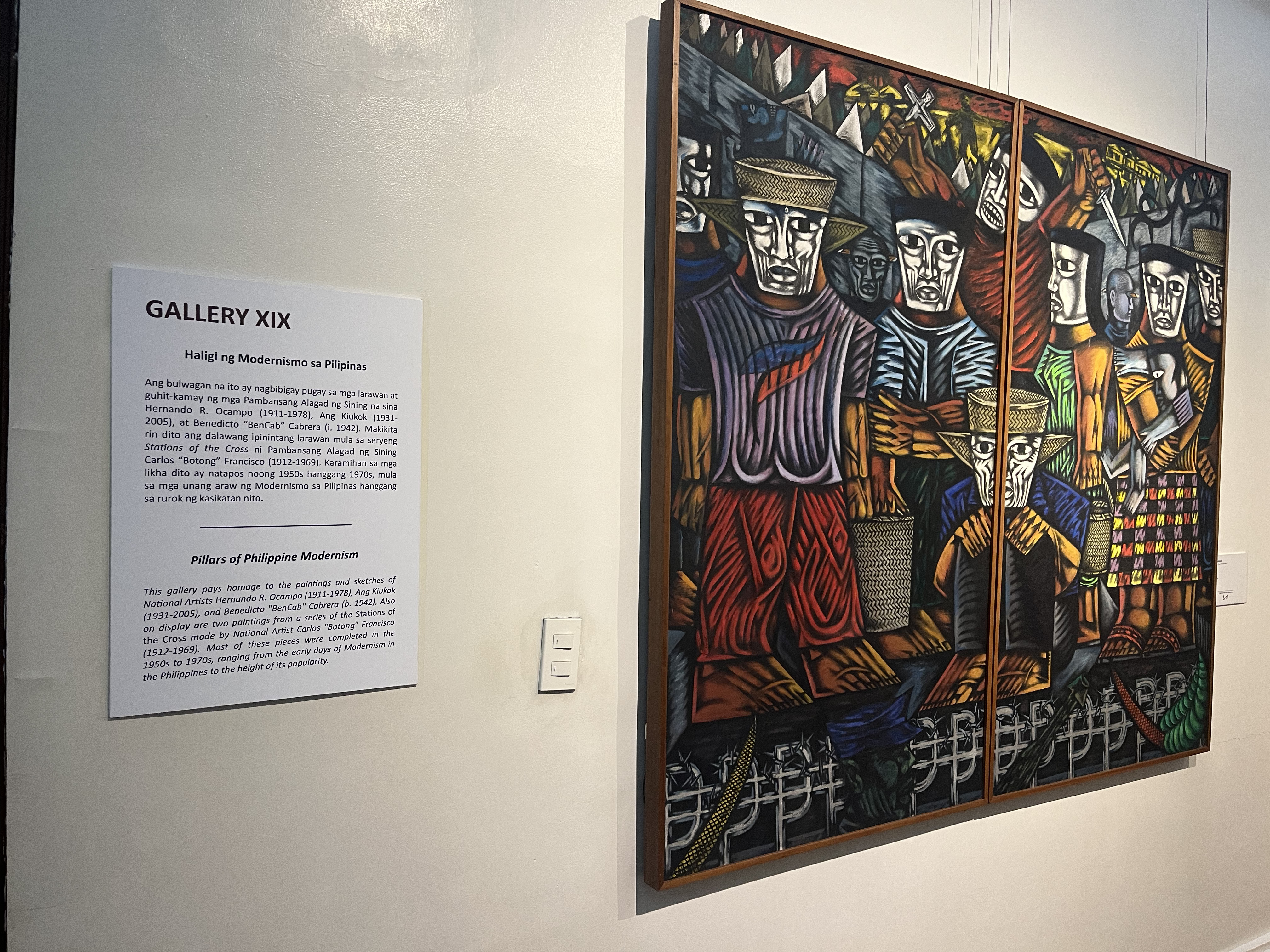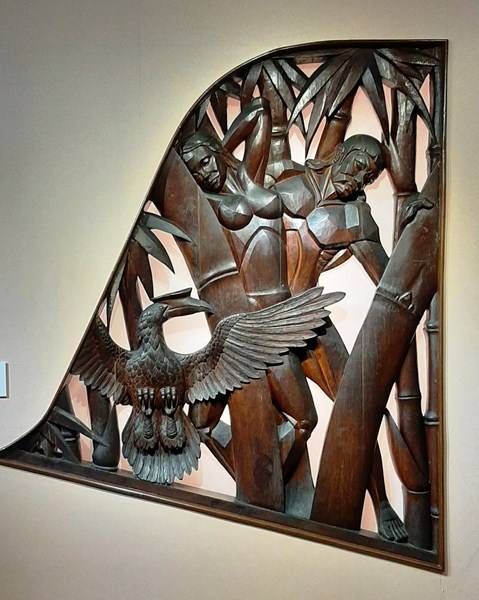
Description
The artwork in question is a medium-sized oil painting titled "Superstitions" by Cesar Legaspi, dating back to 1982 and housed in the National Museum collection. The painting depicts a man in distress, hands on his head, within a composition featuring muscular, structural forms characterized by layered curved and diagonal figures and shapes. The shapes, of varying thickness and irregular sizes, overlap, creating a sense of dynamism. The vertical axis suggests an inverted orientation. The rhythmic curvilinear and plane elements are notably emphasized, contributing to a smooth surface, a departure from typical oil painting textures.
Formal Analysis
Upon closer inspection, the man's head takes center stage with irregular shapes forming a geometric and structural structure. Repetitive shapes create a transparent, three-dimensional effect, resembling a non-triangular prism. Curved and diagonal lines convey a sense of movement, evoking struggle and danger. The blue and brown color palette contrasts effectively, with a flame-like element at the bottom suggesting fire and the upper section hinting at water or air. Dark shades add depth, while tints are enhanced by ambient light. The artist's skillful use of oil paint produces a sensual chromatic ambiance. However, the composition lacks balance due to the man's leg positioning and the disproportionate size of his hand, disrupting symmetry. Initially, I was captivated by the unconventional use of geometrical figures and the impactful monochromatic color scheme, conveying a poignant portrayal of human struggle.
Interpretation
Discovering the title "Superstitions" reveals a thematic interpretation. The painting appears to symbolize the pitfalls of blind adherence to false beliefs. The inverted position of the man, hands on his head in apparent distress, reflects the consequences of succumbing to superstitions. The contrasting blue and brown regions may represent elements of air, water, and fire, symbolizing the individual's descent into misguided beliefs. The bareness of the figure suggests innocence and vulnerability, illustrating the ease with which society can influence and manipulate. Additionally, the color choice of blue and brown may symbolize the Philippines, urging a stand for one's beliefs and a rejection of societal dictates, emphasizing the potential for danger and suffering.
Evaluation
Looking at the artwork in terms of its design, the artist's style, meaning, and originality, it becomes clear that it's a significant piece. Cesar Legaspi's Neo-realism, influenced by cubism and geometrical shapes, brings a unique and original artistic expression. The painting effectively talks about society, mixing old and new ideas. Legaspi's way of expressing himself through art covers a wide range of feelings and characteristics, from being sensitive to strong, powerful to graceful, and lyrical to dynamic. Taking all these aspects into account, the artwork is not just a reflection of the artist's feelings; it also connects with and affects society, contributing to discussions about the human experience, especially that of Filipinos.

Description
The Mother and Child sculpture is a massive piece crafted from solid adobe, portraying abstract figures of a woman seated and cradling a child. Their interaction suggests a scene of play, capturing the essence of a mother’s love and a child’s joy, reflecting the playful personality of the artist, Napoleon V. Abueva. F. Sionil Jose, a National Artist for Literature, highlighted Abueva's playful nature and its reflection in his work, emphasizing the transformation of once living trees into beautiful, reimagined forms. This metamorphosis embodies the uniting power of beauty amidst a fractured society, shaped by brave and caring hands.
Formal Analysis
Throughout Abueva’s body of work, the recurrent theme of motherhood serves as a consistent thread, offering a basis for comparing his diverse artistic techniques. The sculpture skillfully incorporated visual components in line with the principles of design to create a composition that is both harmonious and emotionally stirring. The artist effectively utilizes balance, with the maternal figure clutching the child in a stance that conveys both strength and tenderness. This portrayal of Mother and Child is widely embraced by visual artists, and the National Museum takes pride in showcasing this masterpiece, recognizing Abueva as a pioneer of Philippine modern sculpture.
Interpretation
Inspired by Brancusi’s Mother and Child sculpture, Abueva embarked on his own artistic journey. The sculpture is meticulously crafted from Adobe stone or volcanic tuff, molded in a cubist form. The intentional choice of material and subject aligns seamlessly with the artwork's central message—natural birth. Despite its simplicity, the sculpture emanates boldness and honesty, conveying the profound connection between a mother and her child. The huge sculpture, which is made of a solid adobe, depicts abstract representations of a mother sitting and cradling a child, the latter of whom is clinging to his mother's head. At plain sight, it may even look like they are playing — an image of a mother’s love and a child’s joy. This mirrors Abueva’s playful personality. National Artist for Literature F. Sionil Jose noted that Billy (Abueva) was a playful artist. He adds, “This playfulness was very much reflected in his work. He was surrounded by ‘junk.’ These were once trees; beautiful living things given new shape. Beauty is what binds us together as a fractured people by brave and caring hands.”
Evaluation
The sculpture transcends mere representation, exuding a powerful voluptuousness and sensuality that alludes to the innate beauty of childbirth and motherhood. The nudity of the figures, though raising questions, contributes to the overall bold and honest expression. Mother and Child not only stands as a revered subject among visual artists but also serves as a testament to a mother's care and love for her child. Its artistic appeal and capacity to capture the complexity and beauty of the mother-child bond are what make it significant.

Description
The Hiligaynon term, “Hulat Sweldo” means delayed wages. This work was produced by Nunelucio Alvarado, a social painter from Negros Occidental. In 1994, Alvarado created his two-panel oil on canvas to stand for the plights and efforts of sakadas or migratory farmworkers. There are the folks at its core, and this color palette makes use of earthy tones that symbolize the grit in the subject matter. This painter incorporates a very realistic approach to convey the subtle complexities of the workers' emotions, their outfits, and overall spirit. The brushstrokes show through and add a lot of texture to the planes, light-dark contrast aids in achieving the three-dimensionality of such a scene.
Formal Analysis
The visual details of “Hulat Sweldo” interplay to suggest the workers' hope and their suffering. The figures were arranged in such a way that they make up one whole. Mixing color to create a terrible atmosphere, the artist uses earth tones that increase the realism in his work. It is in such a process that design concepts, including balance and unity, are used to illustrate collective effort. The brush and texture enhance the sense of the subject matter making it emotional while painting. The use of light and darkness gives the characters generalized characteristics, drawing attention to their physical work. In terms of cultural and stylistic elements, social realism is shown in paintings that are related to one another alongside societal issues.
Interpretation
Alvarado's artwork questions the human suffering that results from waiting for their wages, highlighting the economic difficulties in the life of a working-class man. It emphasizes their patience and perseverance in the face of economic uncertainty. The environment reflects an identifiable moment that socially always evokes sympathy and understanding of the needs of people who depend on immediate payment for their sustenance.
Evaluation
A dramatic representation of the human state is Hulat Sweldo's forte, in this case portraying the economics suffered by the workers. They are represented by an artistic form, realism in the details, and visual impact perfectly used. The portrayal of a valuable and authentic part of everyday life is unmasked. The importance of the painting as a social comment prompt one to contemplate the human suffering that labor endures. The emotional involvement promoted by the choice of composition and theme makes the artistic work more whole. However, the painting could be seen as an empowering and thought-provoking creation that adds value to an applicable discussion on the reality of society through visual arts medium.

Description
Carved Narra Wood Malakas at Maganda (The First Man and Woman) is a remarkable sculpture created by Jose P. Alcantara. Standing at approximately three feet tall, this piece exudes an aura of ancient mystique and cultural significance. The sculpture intricately portrays the mythical characters of Malakas and Maganda, who are widely recognized as the first man and woman in Philippine folklore. The sculpture is meticulously crafted from narra wood, a highly prized hardwood native to the Philippines known for its strength and durability. Its rich, warm hues and distinct wood grain add to the overall allure of the piece. The attention to detail is evident, as each contour and expression is skillfully rendered, capturing the essence of the characters' legendary status. Upon closer observation, one can appreciate the artistic precision employed in the construction of the sculpture. The textured surface of the narra wood and the smoothness of the carved features beautifully complement one another, reflecting the artist's mastery of his craft. The positioning of the figures suggests a sense of motion, as if frozen in the midst of an important narrative moment. In adhering to the guidelines provided, it is important to note that this description does not offer any subjective judgment on the quality or technique of the artwork, nor does it attempt to interpret any underlying meaning or symbolism within the piece. Instead, the focus remains on objectively highlighting the physical attributes of the artwork, such as its material, construction, and overall artistic presentation.
Formal Analysis
The description of the artwork reveals the mastery of the artist. The sculpture is meticulously crafted from narra wood, a dense and durable hardwood native to the Philippines. The choice of material not only adds to the artwork's aesthetic appeal but also signifies its cultural significance. The detailed craftsmanship is evident in the realistic portrayal of Malakas and Maganda, highlighting their muscular physiques and graceful contours. When examining the visual elements, one can observe how the principles of design are effectively employed. The composition is balanced, with Malakas standing tall and Maganda gracefully leaning against him, suggesting their harmonious unity. The sculpture's lines and forms are smooth and flowing, creating a sense of movement. The artist's deliberate use of contrasting textures, such as the polished wood surfaces and the rough and textured hair, adds depth to the artwork. Symbolism plays a significant role in the piece, representing the cultural and mythological aspects of Filipino tradition. Malakas and Maganda are not only depicted as the first human beings but also as the ancestors of the Filipino people. Through their representation, the sculpture embodies the country's rich history and origins. Furthermore, the artist's process and techniques are crucial to understanding the artwork's creation. The use of narra wood necessitates talent and precision, as wood carving requires special tools and expertise. By employing traditional carving techniques, Alcantara pays homage to the cultural heritage of the Philippines and ensures the longevity of artistic practices. Alcantara's "Carved Narra Wood Malakas at Maganda" is a remarkable artwork that surpasses mere visual appeal. It successfully combines technical excellence with cultural symbolism to create a meaningful representation of Filipino folklore. Through a comprehensive analysis of its description and visual elements, one can appreciate the artist's skill and the artwork's profound significance in both artistic and cultural contexts.
Interpretation
The sculpture "Malakas at Maganda (The First Man and Woman)" by Jose P. Alcantara is a powerful representation of the rich cultural heritage of the Philippines. The names of the characters, Malakas and Maganda, have a deeper meaning beyond mere identification; they represent the roles and dynamics within Filipino society. The sculpture symbolizes men as pillars of strength and resilience, while women are depicted as embodiments of beauty, sweetness, and gentleness. The lateral breaking of the bamboo in the sculpture represents the principle of equality, suggesting that despite the apparent distinctions in roles, both men and women share a harmonious and balanced partnership. Alcantara's work not only captures the essence of traditional gender roles but also conveys a subtle message about the interconnectedness and mutual dependence that characterize Filipino familial bonds.
Evaluation
Jose P. Alcantara's masterful sculpture, 'Malakas at Maganda (The First Man and Woman),' serves as a captivating exploration of Filipino mythology and cultural heritage. Through a meticulous amalgamation of various artistic elements, including form, composition, and symbolism, the artist adeptly unravels the captivating tale of the first man and woman in Filipino folklore. Alcantara's choice of materials and technique showcases a profound understanding of his craft, breathing life into the sculpted characters and infusing the artwork with a palpable sense of cultural richness and historical significance. The sculpture's composition stands as a testament to the artist's keen eye for harmony, with the deliberate arrangement of shapes and lines contributing significantly to the overall narrative impact. Alcantara's attention to detail and commitment to craftsmanship is unmistakable, elevating the emotional resonance of the artwork and inviting viewers to immerse themselves in the intricacies of its creation. Within the sculpture, symbolic elements are strategically embedded, adding layers of depth and meaning that prompt audiences to delve into the cultural and mythological dimensions woven into the fabric of the work. 'Malakas at Maganda' not only holds a pivotal place within Mr. Alcantara's expansive body of work but also emerges as a thought-provoking and aesthetically powerful contribution to the broader art discourse. Its narrative captivates viewers, while its cultural depth encourages contemplation and exploration. In this way, Alcantara's sculpture transcends its physical form, becoming a dynamic conduit for engaging audiences in a profound dialogue about heritage, mythology, and the enduring power of artistic expression.

Description
“Reminiscencia No. 25” by Federico Aguilar Alcuaz is a captivating painting that immediately draws attention with its vibrant colors and dynamic composition. The canvas is filled with a symphony of hues, ranging from bold reds and blues to softer yellows and greens. The artist employs a combination of broad and intricate brushstrokes, creating a textured surface that adds depth to the piece. The central focus seems to be a geometric form, possibly a vase or an abstract representation, surrounded by a burst of energetic shapes and lines. The composition exudes a sense of movement and vitality, inviting the viewer to explore the intricacies of the artist’s visual language.
Formal Analysis
In terms of formal elements, Aguilar Alcuaz masterfully employs color, line, and texture to convey a sense of dynamism and emotional intensity. The bold use of color not only establishes a vibrant palette but also creates a visual hierarchy within the composition. The juxtaposition of warm and cool tones enhances the overall balance and harmony. The artist’s skillful manipulation of line contributes to the sense of movement, with flowing curves and sharp angles guiding the viewer’s gaze. The textured surface, achieved through layered brushstrokes, adds a tactile quality to the work, inviting closer inspection. Aguilar Alcuaz’s formal choices reflect a deliberate and sophisticated approach to composition, showcasing his mastery of technique.
Interpretation
“Reminiscencia No. 25” invites interpretation as a celebration of life and emotion. The dynamic composition and vivid colors suggest a sense of exuberance and joy, while the central form may symbolize the essence of memories or experiences being recollected. The intertwining lines and shapes could represent the complexity and interconnectedness of human emotions and relationships. The use of abstraction allows for multiple interpretations, encouraging viewers to engage with the painting on a personal and emotional level. Aguilar Alcuaz’s work transcends a mere depiction of visual elements, inviting contemplation on the deeper, subjective aspects of the human experience.
Evaluation
Aguilar Alcuaz’s “Reminiscencia No. 25” stands as a testament to his artistic prowess and ability to convey complex emotions through visual language. The painting’s vibrant and dynamic composition captivates the viewer, showcasing the artist’s adeptness in utilizing color, line, and texture. The deliberate abstraction and openness to interpretation make it a piece that resonates on a profound level, inviting viewers to connect with their own experiences and emotions. The technical skill displayed in the formal elements elevates the work to a level of artistic excellence, solidifying Aguilar Alcuaz’s contribution to the world of contemporary art. “Reminiscencia No. 25” serves as a compelling example of how art can transcend the literal and communicate the intangible aspects of the human condition.